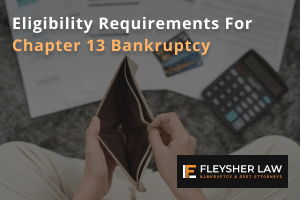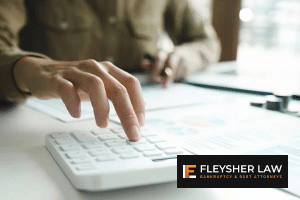This page was written, edited, reviewed & approved by Emil J. Fleysher following our comprehensive editorial guidelines. Emil J. Fleysher, the Founding Partner, has 15+ years of legal experience as a bankruptcy attorney. Our last modified date shows when this page was last reviewed.

When it comes to managing overwhelming debt, Chapter 13 bankruptcy offers a beacon of hope for many. It's a powerful tool that permits individuals to reorganize their debts. With a firm plan, you will have a path to financial recovery without losing your assets. This type of bankruptcy is not for everyone, though. It requires a steady income and falls within specific debt limits to qualify. At Fleysher Law, we can help you decide if this option is right for you.
Chapter 13 bankruptcy stands out because it caters to those with a regular income who seek to clear their debts while retaining their property. It's particularly appealing for individuals who have fallen behind on mortgage payments and wish to prevent home foreclosure. It’s also frequently utilized to save vehicles from repossession. By choosing Chapter 13, debtors commit to a structured debt repayment plan, typically spanning three or five years, demonstrating a commitment to resolving their financial troubles responsibly. The payment amount is rarely based on the actual debt and instead, is based on affordability or your actual ability to pay. For this reason, most Ch. 13 plans only repay a tiny fraction of the total debt being discharged.
Chapter 13 bankruptcy serves as a financial lifeline, enabling individuals overwhelmed by debt to find relief. It differs significantly from Chapter 7 bankruptcy, which liquidates assets to pay off debts. Chapter 13 focuses on debt reorganization, allowing debtors to keep their assets and pay off debts over an agreed period.
Chapter 13 bankruptcy, often termed a wage earner's plan, is for individuals with regular income. Through this path, you can develop a plan to repay all or part of your debts. Under this plan, debtors propose a repayment plan to make gradual payments to creditors. Generally, the payment term is three to five years.
This bankruptcy type is designed to help those with a steady income but struggle to manage their debt. It offers a way to stop foreclosure on a home, make up missed mortgage payments, and restructure other secured debts. Additionally, it can protect co-signers from the repercussions of bankruptcy and prevent utilities from being shut off.

Certain criteria must be met to file for Chapter 13 bankruptcy. This option is not available to everyone, and understanding these requirements is the first step toward filing.
Chapter 13 is primarily for individual debtors or sole proprietors who personally guarantee their business debts. It's not available to corporations or partnerships.
Eligibility hinges on having a regular source of income and total debt that does not exceed specified limits. This ensures that the debtor can maintain a repayment plan. Individuals must also be up-to-date on their tax filings, as this demonstrates financial responsibility and compliance with federal laws.
There are specific debt limits for filing under Chapter 13. Your unsecured debts (like credit card debts and personal loans) and secured debts (such as mortgages) must fall within these limits.
This bankruptcy chapter also distinguishes between unsecured and secured debts, prioritizing the repayment of certain debts. Priority debts, like child support, are non-negotiable and must be paid in full through the repayment plan.
A key component of Chapter 13 eligibility is having enough income to cover your repayment plan. This income can come from various sources, not just your job.
Disposable income is crucial for a Chapter 13 repayment plan. It's the income left after paying necessary living expenses.
The bankruptcy court examines your disposable income to ensure it covers your proposed repayment plan. This calculation helps determine how much you'll pay to unsecured creditors, including credit card debts or medical bills.

In Chapter 13 bankruptcy, how much you pay back depends on whether your debts are secured or unsecured. This distinction affects your repayment plan.
Secured debts are those tied to an asset, like a house or car. Chapter 13 can help pay these debts without losing your property. On the other hand, unsecured debts don't have any collateral backing them. While you may not have to pay these in full, you must use any available disposable income to repay these debts as part of your plan.
Filing for Chapter 13 bankruptcy entails several steps, starting with credit counseling and culminating in the bankruptcy court approving your repayment plan.
Prior to filing for bankruptcy, completing credit counseling from an approved agency is a necessary step. This requirement ensures you understand all debt relief options.
The counseling session provides a clear picture of your finances and might even suggest a debt management plan as an alternative to bankruptcy.
The bankruptcy petition is a detailed document that lists your debts, assets, income, and expenses. Filing this petition officially starts your bankruptcy case.
Alongside the petition, you'll propose a repayment plan based on your disposable income, outlining how to pay back your debts. This plan requires approval from a bankruptcy judge and is central to the Chapter 13 process.

Chapter 13 bankruptcy allows you to reorganize your debts into a manageable repayment plan. This plan accounts for your ability to pay and often results in lower monthly payments.
By filing for Chapter 13, you also gain immediate protection from creditor harassment and legal actions. The automatic stay goes into effect. This prevents creditors from trying to recover any money from you. This protection extends throughout the duration of your bankruptcy case, offering peace of mind as you work towards debt relief.
Life after Chapter 13 bankruptcy offers a fresh start. You don't have to worry about carrying overwhelming debt. You emerge with a cleaner financial slate but must continue practicing responsible financial habits.
Successfully completing your Chapter 13 repayment plan is a significant achievement. It demonstrates your commitment to handling your debts and can considerably improve your credit score over time.
This completion also relieves the debts included in your plan. You'll have more financial freedom and a better foundation for future financial planning.
Upon completing your repayment plan, you may receive a discharge of any remaining unsecured debts. This discharge means you're no longer legally required to pay these debts.
Certain debts, however, like child support, alimony, and specific taxes, cannot be discharged. Understanding which debts will remain even after your bankruptcy case concludes is crucial.

Fleysher Law stands ready to assist you with your Chapter 13 bankruptcy filing. Our expertise ensures that your case proceeds smoothly. Considering filing for Chapter 13 bankruptcy can be daunting, but you don't have to navigate this process alone. Fleysher Law brings a wealth of experience and a compassionate approach to every case, providing the support you need to achieve financial recovery.
With Fleysher Law on your side, you gain a partner committed to your financial well-being. Our law office works tirelessly to protect your interests, offering personalized solutions to meet your unique situation. Call us today to schedule a consultation with our bankruptcy attorney to discuss your secured and unsecured debt.

Emil specializes in consumer bankruptcy, debt settlement, and mortgage modification, offering a holistic approach to solving mortgage and debt problems. Emil listens to clients, understands their circumstances and goals, and helps them make the right choices by presenting all options and contingencies.
He is dedicated to helping South Floridians regain their financial freedom from overwhelming debt caused by high interest credit cards, bad mortgage loans, and uninsured medical expenses.

"*" indicates required fields